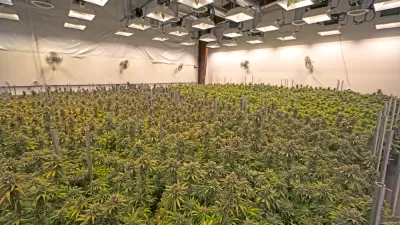Officials overseeing cannabis implementation are having to deal with residents’ complaints that the smell from marijuana operations is overwhelming.

Recreational cannabis has been legal in California since January, but one part of implementation and regulation is proving challenging. In counties throughout the state, residents describe the smells emanating from commercial operations as something akin to skunk, rotting lemons, and sulfur, reports Thomas Fuller:
"It’s as if a skunk, or multiple skunks in a family, were living under our house," said Grace Guthrie, whose home sits on the site of a former apple orchard outside the town of Sebastopol. Her neighbors grow pot commercially. "It doesn’t dissipate," Ms. Guthrie said. "It’s beyond anything you would imagine."
Cannabis growers say that smells are an expected part of agricultural operations, but municipalities were not prepared for odor to be a primary issue related to marijuana production. "Of the more than 730 complaints Sonoma County has received about cannabis this year, around 65 percent are related to odor, according to Tim Ricard, the county’s cannabis program manager," says Fuller.
Residents in Sonoma County are calling for a ban on cannabis operations; Mendocino County has established zones where it is prohibited. Odor-control systems are another strategy for dealing with the stink, but this equipment is expensive and many operators cannot afford it.
Also, part of the problem for local officials is developing a standard for smells, which can be subjective and hard to quantify. Colorado, which legalized cannabis in 2014, uses a device called the Nasal Ranger to measure odor levels. California, however, has yet to adopt this technology.
FULL STORY: ‘Dead Skunk’ Stench From Marijuana Farms Outrages Californians

Alabama: Trump Terminates Settlements for Black Communities Harmed By Raw Sewage
Trump deemed the landmark civil rights agreement “illegal DEI and environmental justice policy.”

Planetizen Federal Action Tracker
A weekly monitor of how Trump’s orders and actions are impacting planners and planning in America.

The 120 Year Old Tiny Home Villages That Sheltered San Francisco’s Earthquake Refugees
More than a century ago, San Francisco mobilized to house thousands of residents displaced by the 1906 earthquake. Could their strategy offer a model for the present?

In Both Crashes and Crime, Public Transportation is Far Safer than Driving
Contrary to popular assumptions, public transportation has far lower crash and crime rates than automobile travel. For safer communities, improve and encourage transit travel.

Report: Zoning Reforms Should Complement Nashville’s Ambitious Transit Plan
Without reform, restrictive zoning codes will limit the impact of the city’s planned transit expansion and could exclude some of the residents who depend on transit the most.

Judge Orders Release of Frozen IRA, IIJA Funding
The decision is a victory for environmental groups who charged that freezing funds for critical infrastructure and disaster response programs caused “real and irreparable harm” to communities.
Urban Design for Planners 1: Software Tools
This six-course series explores essential urban design concepts using open source software and equips planners with the tools they need to participate fully in the urban design process.
Planning for Universal Design
Learn the tools for implementing Universal Design in planning regulations.
Clanton & Associates, Inc.
Jessamine County Fiscal Court
Institute for Housing and Urban Development Studies (IHS)
City of Grandview
Harvard GSD Executive Education
Toledo-Lucas County Plan Commissions
Salt Lake City
NYU Wagner Graduate School of Public Service





























